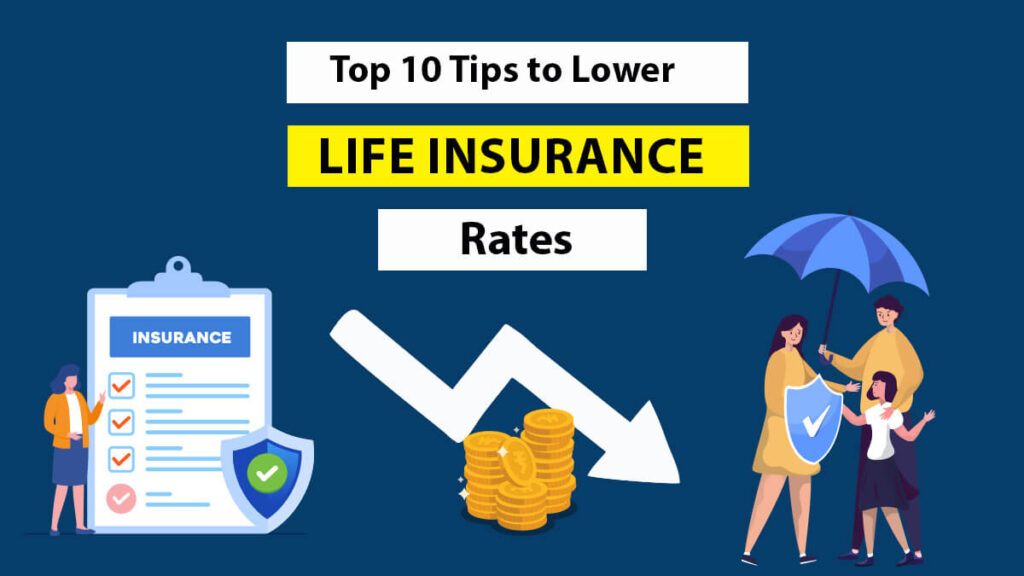
Life insurance is an important part of financial planning but can be expensive. Fortunately, there are ways to lower your life insurance rates and make sure you’re getting the coverage you need at a price you can afford. This article will provide you with the ultimate tips and tricks to help lower your life insurance rates so that you can get the coverage you need without breaking the bank.
What are Life Insurance Rates and Why Should You Care?
Life insurance rates refer to the amount of money that an individual pays in premiums to an insurance company in exchange for a death benefit payout to their designated beneficiary upon their passing. The rate or premium an individual pays is typically based on their age, health, lifestyle, and the coverage they want.
Life insurance rates are important because they directly impact the cost of coverage and the amount of money paid to the beneficiary upon the policyholder’s passing. A lower rate or premium can mean that an individual can afford more coverage, while a higher rate can make coverage more expensive and potentially unaffordable.
Additionally, life insurance rates can vary between insurance companies, making it important to shop around and compare rates to ensure that an individual is getting the best possible coverage at the most affordable price.
Ultimately, understanding life insurance rates is crucial for anyone who wants to protect their loved ones financially in the event of their passing. By carefully considering their options and choosing the right coverage at the right price, individuals can ensure that their beneficiaries will be taken care of when they can no longer provide for them.
What Factors Can Affect Your Life Insurance Premium Rates?
Several factors can affect your life insurance rate or premium. Insurance companies consider a range of factors to determine the likelihood of a policyholder passing away and, therefore, the level of risk associated with insuring that individual. The following are some of the factors that can affect your life insurance rate:
- Age: Generally, younger individuals are less likely to pass away, so they may receive a lower premium compared to older individuals.
- Health: Individuals in good health may receive a lower premium compared to those with pre-existing medical conditions or who have engaged in risk behaviours.
- Family Health History: A family history of certain illnesses or conditions can also impact your life insurance rate.
- Gender: Statistically, women have longer lifespans than men and may therefore receive a lower premium.
- Lifestyle Factors: Certain lifestyle factors, such as tobacco use, excessive alcohol consumption, and participation in dangerous hobbies or occupations, can increase your premium.
- Coverage Amount: The more coverage you want, the higher your premium will typically be.
- Term Length: The length of the policy term can also affect your premium, with longer terms generally resulting in higher premiums.

Top 10 Tips on How to Lower Life Insurance Premium Rates
Planning for your future and the future of your family is a priority for many. Life insurance is one way to help ensure that your loved ones are taken care of in the event of an unexpected death. However, life insurance premiums can be expensive and it can be difficult to know how to lower them. So, we are here to help you and give some tips on how to lower life insurance premium rates so you can save money while still protecting your family’s future. Here are the top ten tips on how to lower life insurance premium rates:
- Get regular check-ups
- Quit smoking
- Choose term life insurance
- Choose a longer policy term
- Maintain a healthy lifestyle
- Purchase coverage early
- Compare & Shop around
- Consider a group policy
- Pay annually
- Review your coverage regularly
By implementing these tips, you can potentially lower your life insurance premiums and ensure that you have the coverage you need to protect your loved ones financially in the event of your passing. Here is a brief explanation of how the top 10 tips will reduce your life insurance premium rates.
Tip #1: Get Regular Check-Ups:
Getting regular checkups can help to reduce your life insurance premium by ensuring that any potential health issues are caught early and that you are managing any pre-existing medical conditions effectively. Insurance companies assess an individual’s risk based on their health status, and those who are healthy and have no pre-existing conditions are considered to be a lower risk, which can lead to lower life insurance premiums.
Additionally, many insurance companies offer lower rates to individuals who can demonstrate that they are managing their health effectively through regular checkups and proper medical care. Providing evidence of regular checkups and good health can help to demonstrate that you are a low-risk individual and can potentially lead to lower life insurance premiums.
Tip #2: Quit smoking:
Quitting smoking can significantly reduce your life insurance premium because smoking is a significant risk factor for many health conditions. Smoking can increase your risk of developing cancer, heart disease, and respiratory problems, which can lead to a shorter life expectancy. As a result, insurance companies typically charge higher premiums for smokers than for non-smokers.
By quitting smoking, you can significantly improve your health and reduce your risk of developing chronic illnesses, which can lower your life insurance rates. Many insurance companies offer non-smoker rates, which can be up to 50% lower than smoker rates.
Tip #3: Choose Term Life Insurance:
Choosing term life insurance can help to reduce your life insurance premium because it is generally less expensive than whole life insurance policies. Term life insurance policies provide coverage for a specific period, usually 5 to 40 years, and pay out a death benefit if the insured person dies during the term of the policy. Because the coverage is limited to a specific period, the premiums are typically lower than whole life insurance policies.
Additionally, term life insurance policies are often more straightforward and have fewer fees than whole life insurance policies. Another factor to consider is that term life insurance policies are often easier to compare and shop for than whole life insurance policies. Because the coverage and premiums are straightforward and predictable, it can be easier to compare policies and find the best rates.
Tip #4: Choose a Longer Policy Term:
Choosing a longer policy term can sometimes help to reduce your life insurance premium. The policy term is the length of time that the policy will be in effect, and premiums are typically based on the policyholder’s age and health at the time of purchase.
By choosing a longer policy term, you may be locking in a lower premium rate for a longer period. For example, if you purchase a 30-year term life insurance policy when you are younger and in good health, you may be able to secure a lower premium rate than if you purchased a 10-year term policy at an older age or with health issues.
Tip #5: Maintain a Healthy Lifestyle:
Maintaining a healthy lifestyle can help to reduce your life insurance premium by reducing your risk of developing chronic illnesses, which can increase your life insurance rates. Insurance companies assess an individual’s risk based on their health status, and those who maintain a healthy lifestyle are considered to be a lower risk, which can lead to lower life insurance premiums.
Eating a balanced diet, exercising regularly, and maintaining a healthy weight can all improve your overall health and reduce your risk of developing chronic illnesses, which can lower your life insurance rates. Insurance companies may offer lower rates to individuals who can demonstrate that they are leading a healthy lifestyle through regular checkups, medical screenings, and other health-related metrics.

Tip #6: Purchase Coverage Early
Early purchasing of a life insurance policy can help to reduce your life insurance premium in several ways including lower rates, more time to build cash value, and avoiding rate increases.
The younger you are when you purchase a life insurance policy, the lower your premium rates are likely to be. This is because younger people generally have fewer health issues and are less likely to pass away shortly, so they are viewed as lower-risk policyholders by insurers. By purchasing a policy early, you may be able to lock in a lower premium rate and save money over the life of the policy.
Certain types of life insurance policies, such as whole life insurance accumulate cash value over time. This cash value can be used to pay premiums or taken out as a loan, among other things. By purchasing a policy early, you have more time to build up this cash value, which can help to reduce your overall premium costs.
Tip #7: Compare & Shop Around:
Comparing and shopping around for life insurance policies can help you to find the best rates and coverage that meet your individual needs. Different life insurance companies offer different rates for the same coverage, so it’s important to compare rates from multiple insurers to find the best deal. By shopping around, you can compare rates and coverage options and choose a policy that meets your needs while also fitting your budget.
Life insurance companies often offer discounts for various reasons, such as being a non-smoker or having a healthy lifestyle. By comparing policies from different insurers, you may be able to take advantage of these discounts and lower your premium.
Tip #8: Consider a Group Policy:
Group policies, such as those offered through employers or professional organizations, often have lower premium rates compared to individual policies. This is because the insurer can spread the risk across a larger pool of people, which can help to lower the overall cost for each policyholder.
Considering a group policy can also help you to reduce your life insurance premium by offering no medical exam requirements, employer contributions, and convenience. It’s important to compare the coverage and rates of group policies to individual policies to ensure that you are getting the best deal for your individual needs.
Tip #9: Pay Annually:
Paying your life insurance premium annually instead of monthly or quarterly can help to reduce your overall premium amount. Insurers often charge additional administrative fees for processing monthly or quarterly payments. By paying annually, you can avoid these fees and reduce your overall premium amount. Some insurers offer discounts for policyholders who choose to pay their premiums annually. These discounts may range from a small percentage to a significant reduction in premium.
By paying annually, you can better manage your cash flow and avoid the hassle of making monthly or quarterly payments. This can help you to avoid late payment fees and improve your credit score. By paying annually, you can lock in your premium rate for the entire year. This can be beneficial if you anticipate changes to your risk profile, as you can avoid potential rate increases by paying upfront.
Tip #10: Review Your Coverage Regularly:
Reviewing your life insurance policy regularly can help you to identify opportunities to reduce your premium. As your life circumstances change, so do your insurance needs. Reviewing your policy can help you to identify areas where your coverage may be outdated or inadequate, which can help to reduce your premium. If you have recently paid off debts or your children have left the home, you may be able to reduce your coverage levels to better match your current needs. This can help to lower your premium without sacrificing important coverage.
Reviewing your beneficiary information can help to ensure that your policy is up-to-date and accurate. This can help to prevent complications and delays in the event of your passing, and may also help to reduce your premium. Reviewing your policy can also be a good time to shop around and compare rates from different insurers. This can help you to identify potential savings opportunities and may lead to a lower premium.

Conclusion
By taking the time to research your options, you can maximize your chances of securing an affordable life insurance policy that meets your needs. From understanding the different types of policies available to compare quotes from multiple providers, there are several steps you can take to ensure you get the best deal on a low-cost life insurance policy. With careful planning and research, you can make sure that you have the protection you need at an affordable price.

These tips provide practical strategies for individuals to reduce their life insurance rates while maintaining adequate coverage, ensuring financial security.
Lowering life insurance rates is achievable with these insightful tips, empowering individuals to make cost-effective decisions about their coverage.
Incorporating these tips into your life insurance strategy can result in significant savings, making quality coverage more accessible and affordable for everyone.
Mastering the art of saving: Top tips to reduce life insurance rates in 2023
Smart strategies for affordable protection: Lowering life insurance rates made easy.